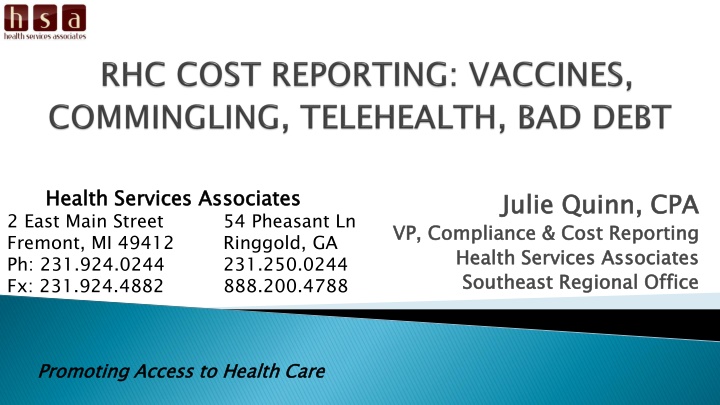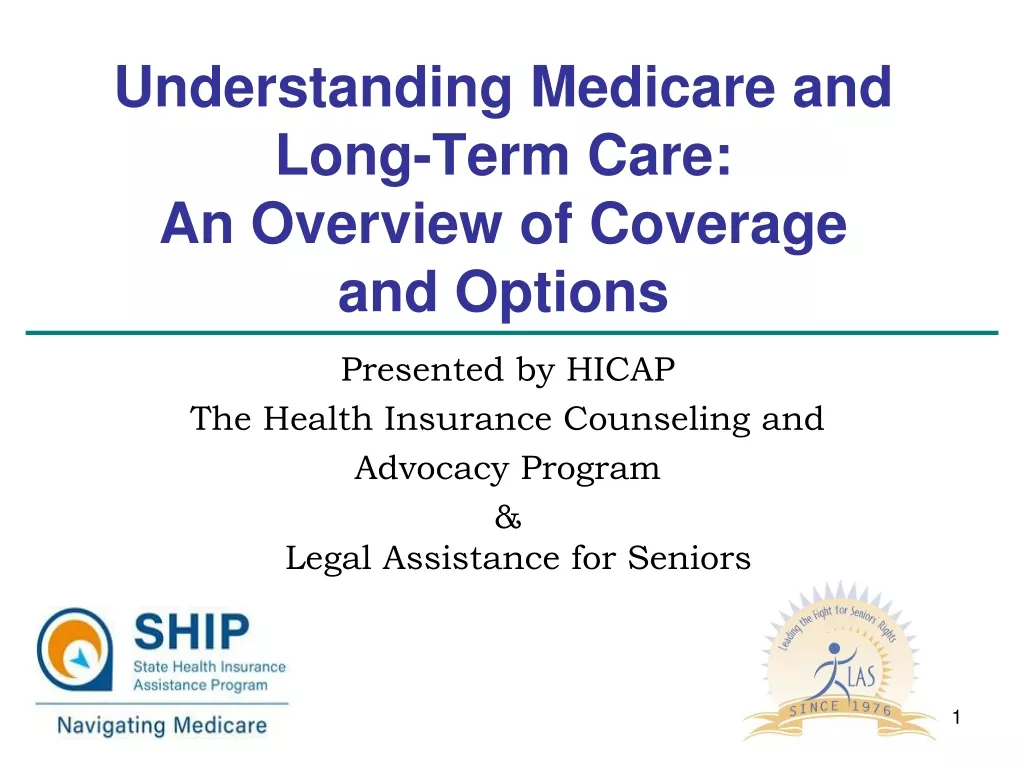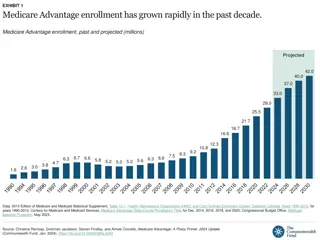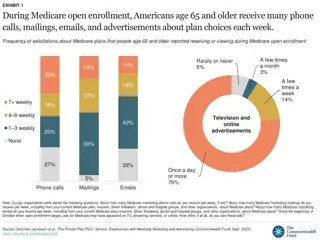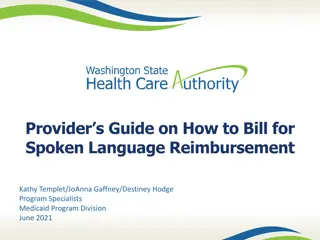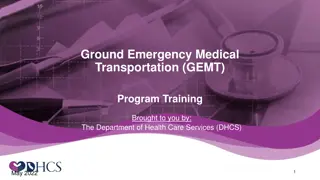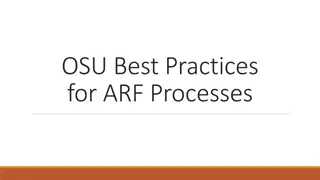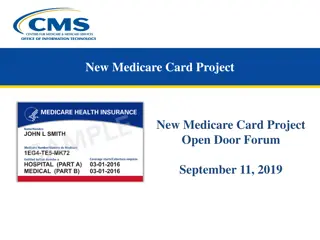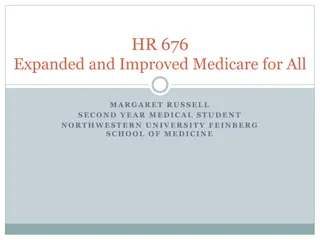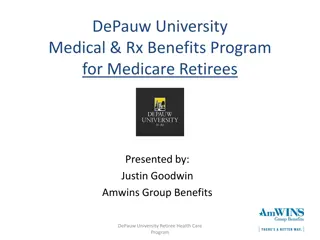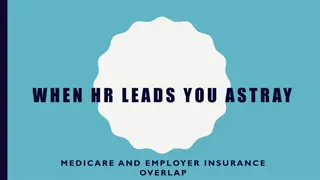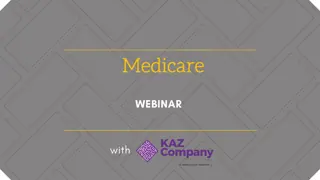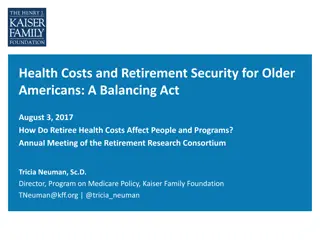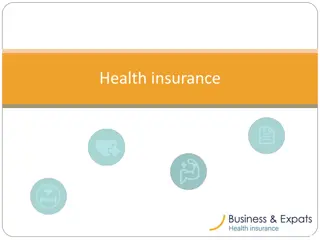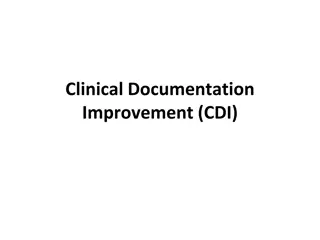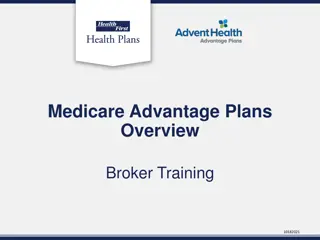Medicare Reporting and Reimbursement Guidelines for Healthcare Providers
Explore essential information on reporting telehealth costs, bad debt claiming, and Medicare reimbursement for Covid vaccines. Learn about reconciliation processes, interim payment determinations, and compliance strategies in healthcare finance. Discover rate calculations, cost worksheets, and payment ceilings for Independent RHCs. Stay updated on regulatory changes and best practices in healthcare financial management.
Download Presentation

Please find below an Image/Link to download the presentation.
The content on the website is provided AS IS for your information and personal use only. It may not be sold, licensed, or shared on other websites without obtaining consent from the author.If you encounter any issues during the download, it is possible that the publisher has removed the file from their server.
You are allowed to download the files provided on this website for personal or commercial use, subject to the condition that they are used lawfully. All files are the property of their respective owners.
The content on the website is provided AS IS for your information and personal use only. It may not be sold, licensed, or shared on other websites without obtaining consent from the author.
E N D
Presentation Transcript
Health Services Associates 2 East Main Street Fremont, MI 49412 Ph: 231.924.0244 Fx: 231.924.4882 Health Services Associates Julie Quinn, CPA Julie Quinn, CPA 54 Pheasant Ln Ringgold, GA 231.250.0244 888.200.4788 VP, Compliance & Cost Reporting Health Services Associates Southeast Regional Office VP, Compliance & Cost Reporting Health Services Associates Southeast Regional Office Promoting Access to Health Care Promoting Access to Health Care
Learn how to report telehealth costs and visits on the cost report Discuss common commingling issues and mitigation strategies Learn how to report and get reimbursed for Covid vaccines and monoclonal antibody treatments Learn what bad debt can be claimed on the cost report and required documentation
Due 5 Months Reconciles actual cost per visit Determines future interim payment It is where you get paid Pneumococcal and Influenza vaccine costs Medicare Bad Debt NEW: Covid vaccine administration & Monoclonal Antibody Products Due 5 Months after clinic s fiscal year end Reconciles Medicare s interim payment method to future interim payment rates get paid for: Bad Debt NEW: Covid vaccine administration & Monoclonal Antibody Products vaccine costs
COST / VISITS =RATE COST / VISITS =RATE
RHC COST / RHC VISITS = = RHC RATE RHC COST / RHC VISITS RHC RATE
Cost: Worksheet A/M-1 A-6 is where we reclassify cost A-8 is where we take things off and put things on Visits: Worksheet B/M-2 Rate/Settlement: Worksheet C/M-3 Vaccines: Worksheet B-1/M-4
Independent RHCs THROUGH APRIL 1, 2021 Subject to a ceiling/cap = $87.52 Independent RHCs THROUGH APRIL 1, 2021: Independent RHCs AFTER APRIL 1, 2021: Subject to a ceiling/cap = $100.00 4/1-12/31/21 Increasing cap through 2028 when cap will be $190.00 Independent RHCs AFTER APRIL 1, 2021:
It then rises as follows: January 1 March 31 $87.52. $87.52. 2022 $113.00 2023 $126.00 2024 $139.00 2025 $152.00 2026 $165.00 2027 $178.00 2028 $190.00 2022 $113.00 2023 $126.00 2024 $139.00 2025 $152.00 2026 $165.00 2027 $178.00 2028 $190.00 On April 1 Dec 31 $100.00 $100.00
Provider based >50 bed hospital same as independent Provider based >50 bed hospital: Capped Provider based <50 bed hospital Actual cost per visit from reports ending in 2020, indexed by MEI for existing RHCs Capped same as others for new provider based RHCs after 12/31/2020 Provider based <50 bed hospital:
RHC COST / RHC VISITS = = RHC RATE RHC COST / RHC VISITS RHC RATE
RHC Healthcare Costs Overhead Non-RHC
Compensation for healthcare staff Compensation for physician supervision Medical Supplies Malpractice/License fees/CME
Malpractice and other insurance (Premium can not exceed amount of aggregate coverage) Professional Dues and Subscriptions Medical Supplies Flu and Pneumo Vaccine and supply costs Direct cost of Monoclonal Antibody treatment supplies
TWO TYPES TWO TYPES FACILITY ADMINISTRATIVE
Rent Utilities Insurance Depreciation Interest on Mortgage Other building expenses
Office salaries Telephone/IT costs Office supplies Other administrative costs Legal/Accounting
Overhead Healthcare Non-RHC
ONLY LEAVE AMOUNTS IN THE NON NEED TO CAPTURE OVERHEAD ONLY LEAVE AMOUNTS IN THE NON- -RHC SECTION IF THEY NEED TO CAPTURE OVERHEAD RHC SECTION IF THEY
If it is paid/covered within the RHC All- Inclusive rate report in RHC section If is it paid outside of the RHC rate out and billed by another entity it is NON RHC paid outside of the RHC rate or carved NON- - RHC
Lab Lab CCM CCM X X- -Ray Ray Telehealth Telehealth EKG EKG
Technical component of Lab, X billed to part B and paid over and above the RHC AIR. Technical component of Lab, X- -Ray, EKG Ray, EKG are If is it paid outside of the RHC rate out and billed by another entity it is NON RHC paid outside of the RHC rate or carved NON- - RHC
Chronic Care Management not paid at the AIR. Chronic Care Management is not a visit and If is it paid outside of the RHC rate out and billed by another entity it is NON RHC paid outside of the RHC rate or carved NON- - RHC
Telehealth AIR. Telehealth is not an RHC visit and not paid at the Telehealth visits Telehealth visits are not reported as RHC visits If is it paid outside of the RHC rate and billed by another entity it is NON paid outside of the RHC rate or carved out NON- -RHC RHC
Overhead Healthcare Non-RHC
Worksheet A-6: Used to reclassify costs to appropriate cost centers to capture overhead Worksheet A-8: Used to non-allowable or non-RHC costs that do not use clinic overhead
Lab, X-ray, EKG Billed to Part B by independent RHCs Billed through hospital and included in hospital costs for provider-based RHCs
Method A: Time the person Method B: Time the test
Method A: Time the person Allocate % of time for non-RHC carve out for staff performing non-RHC lab/ X-ray/EKG duties vs. RHC duties Time studies of staff to support the allocated carve out
Method B Time the test Calculate time per test Multiply by number of tests performed
Take hours calculated from Method A or B Multiply by average hourly wage Reclassify resulting non-RHC wages into non-reimbursable cost center
Is CCM handled by an outside company? Exclude direct CCM costs Exclude associated billing costs/incremental overhead costs
Is CCM done in the clinic, by clinic staff? Reclassify direct healthcare staff costs into Non- RHC cost center New line 80 on independent reports
If staff performing CCM and/or Telehealth wear multiple hats in your clinic, use same calculations/methods as Lab/X-Ray/EKG Method A: Time the person Method B: Time the service
Take hours calculated from Method A or B Multiply by average hourly wage Reclassify resulting non-RHC wages into non-reimbursable cost center
Pre-COVID: RHCs may serve as an originating site for telehealth services During PHE: RHCs may serve as either the originating or distant site Originating site is the location of the patient at the time of service.
Cost of providing telehealth services must be classified in the Non-RHC section on Line 79 for Independent, Line 25.01 Provider Based
Method A: Time the person Complete time studies Method B: Time the visit Average per partial time studies Average using CPT
Method A: Time the person Allocate % of time for non-RHC carve out for staff performing telehealth visits Time studies of staff to support the allocated carve out
Method B Time the average visit Partial time studies CPT codes basis Other Multiply by number of tests performed
Take hours calculated from Method A or B Calculate telehealth hours as a percent of total healthcare hours Multiply by total healthcare wages Reclassify resulting non-RHC wages into non-reimbursable cost center Health Services Associates, Inc.
Rules on Comingling can be found in the Medicare Benefit Policy Manual Chapter 13 Section 100 Commingling Health Services Associates, Inc.
Commingling refers to the sharing of RHC or FQHC space, staff (employed or contracted), supplies, equipment, and/or other resources with an onsite Medicare Part B or Medicaid fee-for-service practice operated by the same RHC or FQHC physician(s) and/or non- physician(s) practitioners. sharing of RHC or FQHC space, staff (employed or contracted), supplies, equipment, and/or other resources
Commingling is prohibited in order to prevent: Duplicate Medicare or Medicaid reimbursement (including situations where the RHC or FQHC is unable to distinguish its actual costs from those that are reimbursed on a fee-for-service basis), or Selectively choosing reimbursement rate for the services. (Known as financial triage ) Duplicate Medicare or Medicaid reimbursement Selectively choosing a higher or lower
RHC and FQHC practitioners may not furnish RHC or FQHC as a Part B provider an area outside of the certified RHC or FQHC space, such as a treatment room adjacent the RHC or FQHC, during RHC or FQHC hours of operation. may not furnish RHC or FQHC- -covered professional services as a Part B provider in the RHC or FQHC, or in covered professional services such as a treatment room adjacent to
If an RHC or FQHC is located in the same building with another entity such as an unaffiliated medical practice, x-ray and lab facility, dental clinic, emergency room, etc., the RHC or FQHC space must be clearly defined FQHC leases space to another entity, all costs associated with the leased space must be carved out of the cost report. space must be clearly defined. If the RHC or all costs associated with the leased space must be carved out of the cost report.
RHCs and FQHCs that share resources (e.g., waiting room, telephones, receptionist, etc.) with another entity must maintain accurate records to assure that all costs claimed for Medicare reimbursement are only for the RHC or FQHC staff, space, or other resources. Any shared staff, space, or other resources must be allocated appropriately between RHC or FQHC and non RHC or non reimbursement. Any shared staff, space, or other resources must be allocated appropriately between RHC or FQHC and non- - RHC or non- -FQHC usage to avoid duplicate reimbursement. FQHC usage to avoid duplicate
This commingling policy does not prohibit a provider-based RHC from sharing its health care practitioners with the hospital emergency department in an emergency, or prohibit an RHC physician from providing on-call services for an emergency room, as long as the RHC would continue to meet the RHC conditions for coverage even if the practitioner were absent from the facility.
The RHC must be able to allocate appropriately the practitioner's salary between RHC and non expected that the sharing of the physician with the hospital emergency department would not be a common occurrence. must be able to allocate appropriately the practitioner's salary between RHC and non- -RHC time. RHC time. It is
